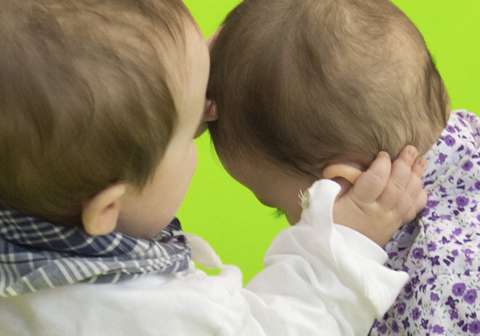How do babies coordinate gestures and vocalization?

Asier Romero-Andonegi, Aintzane Etxebarria-Lejarreta, Ainara Romero-Andonegi and Irati de Pablo-Delgado, lecturers and researchers at the UPV/EHU's University College of Teacher Training in Bilbao, have studied how nine to 13-month-old babies tackle the shift from early babbling to the use of combinations of gestures and speech. The work, titled "The interrelation of gestures and vocalization in early communication functions: Evidence from Basque language" has been published in the journal Signos.
Science shows that human language and communication cannot be studied solely by analysing speech. Among the contributions made by this work, Asier Romero, researcher in the Department of Language and Literature Didactics of the University College of Teacher Training in Bilbao, highlights the fact that this is the first study conducted on children whose first language is Basque, and which shows how and when babies develop and use "a pattern to coordinate gestures with speech."
"We have discovered that when a baby abandons the characteristic babbling for vocalizations of repeated, long chains of syllables at 9 months and starts the more complex pre-language phase around 11 months, her gestures begin to be produced mainly in combination with vocal production rather than as an act of gestures alone. In other words, the gestural and speech systems are already closely related," explained Romero.
The researcher was also keen to stress that the typology of the gestures in these combinations are "mainly deictic"; in other words, they display "a declarative intention and involve implementation gestures, such as pointing, giving, showing, offering and making requests in order to direct the attention of an adult towards the object that the baby is interested in obtaining—in other words, to inform the adult about his/her interest in the object."
As far as Romero is concerned, this study shows that speech and gestures are two "essential elements" in human communication because there is increasing evidence that both are closely coordinated, and "it is perhaps a fundamental condition for the subsequent development of early vocabulary during the language phase."
Accumulating evidence shows that the combination of babbling and gestures of babies are related to the subsequent development of language, and therefore contribute to a predictive model. "Research of this type could help to predict language alterations in specific language disorders," said the researcher.
The aim of this pioneering work was to explore the process of language acquisition and development in relation to the time-related coordination of gestures and speech in children. To do this, the researchers recorded on video two babies born into Basque-speaking families from nine months to 13 months.
The recordings were made in their homes in the company of their parents. A total of over 1,260 examples of speech were obtained; they were produced by each baby across about 6 hours' worth of recordings that were later analysed by applying specific ELAN software. "This tool allows us to make and process annotations in digital lines of information in a joint way for a range of audio and video files," he explained.
More information: Asier Romero et al. Interrelación entre gestos y vocalizaciones en funciones comunicativas tempranas: Evidencias desde la lengua vasca, Revista signos (2017). DOI: 10.4067/S0718-09342017000100005


















